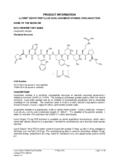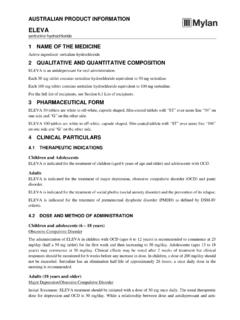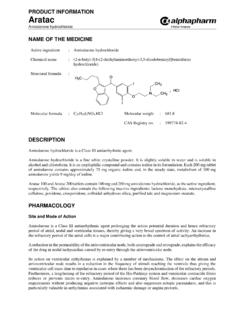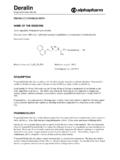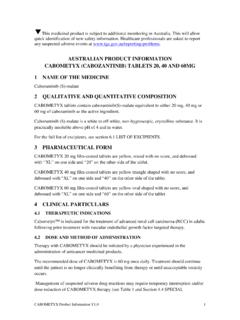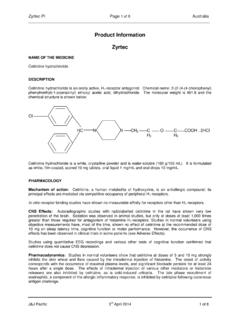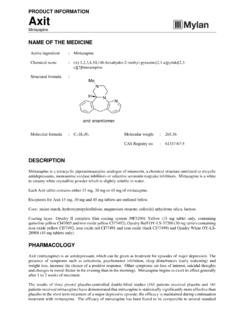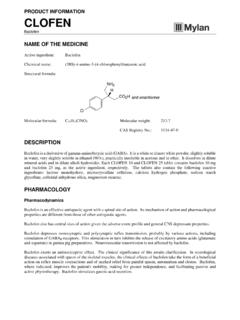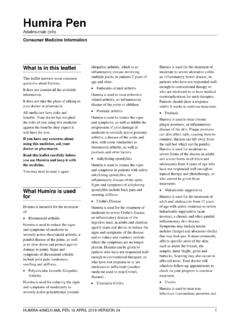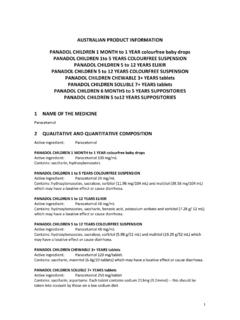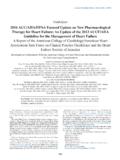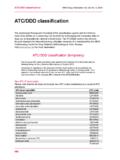Transcription of QUALITATIVE AND QUANTITATIVE COMPOSITION
1 Australian product information PREXUM (perindopril arginine) Version: 8 1/26 AUSTRALIAN PI: PREXUM (PERINDOPRIL ARGININE) FILM-COATED TABLETS 1 NAME OF THE MEDICINE Perindopril arginine 2 QUALITATIVE AND QUANTITATIVE COMPOSITION Each PREXUM tablet contains mg of perindopril arginine. Each PREXUM 5 tablet contains 5 mg of perindopril arginine. Each PREXUM 10 tablet contains 10 mg of perindopril arginine. Excipient with known effect: contains sugars as lactose For the full list of excipients, see section - List of excipients. 3 PHARMACEUTICAL FORM PREXUM is a white, round, convex, film-coated tablet. PREXUM 5 is a light-green, rod-shaped, film-coated tablet engraved with a logo on one face and scored on both edges. PREXUM 10 is a green, round, biconvex film-coated tablet with a logo on one face and a logo on the other face. 4 CLINICAL PARTICULARS THERAPEUTIC INDICATIONS PREXUM is indicated for: the treatment of hypertension; the treatment of heart failure.
2 In such patients it is recommended that PREXUM be given with a diuretic and/or digoxin under close medical supervision. (The safety and efficacy of PREXUM has not been demonstrated for New York Heart Association Category IV patients); and patients with established coronary artery disease (see section - Pharmacodynamic properties) who are stable on concomitant therapy and have no heart failure to reduce the risk of non-fatal myocardial infarction or cardiac arrest. DOSE AND METHOD OF ADMINISTRATION Hypertension The usual starting dose is one PREXUM 5 tablet once daily, taken in the morning. Optimum control of blood pressure is achieved by increasing the dose, titrating it against the blood pressure to a maximum of one PREXUM 10 tablet once daily. A starting dose of one PREXUM tablet once daily is recommended in the following patients who may be at risk of ACE inhibitor-induced hypotension: Australian product information PREXUM (perindopril arginine) Version: 8 2/26 Combination with a Diuretic The administration of PREXUM to patients under current treatment with a diuretic may induce hypotension and sometimes, but more rarely, acute renal failure, at the beginning of the treatment.
3 Monitoring of plasma creatinine is recommended during the first month of treatment. Elderly patients with hypertension Elderly patients with hypertension should start treatment with one PREXUM tablet once daily, with titration to one PREXUM 5 tablet once daily if necessary. It is recommended that renal function be assessed before starting treatment. Other patients who may be at risk of ACE inhibitor-induced hypotension Patients with renovascular hypertension, salt and/or volume depletion, or cardiac decompensation may have a strongly activated RAAS. These patients may experience an excessive drop in blood pressure following the first dose of an ACE inhibitor. Congestive Heart Failure Treatment of congestive heart failure with PREXUM should be initiated under close medical supervision. The usual starting dose is one PREXUM tablet once daily which should be given with a diuretic and/or digitalis.
4 This is increased to one PREXUM 5 tablet once daily for maintenance. Patients with severe hepatic or renal impairment and/or severe salt/volume depletion are particularly sensitive to ACE inhibitors. Doses in these patients should be carefully titrated as no pharmacokinetic and dose titration studies have been conducted. Reduction of risk of cardiovascular events For stable coronary artery disease, the starting dose is one PREXUM 5 tablet once daily for two weeks, and then increased to one PREXUM 10 tablet once daily, depending on tolerance and renal function. Elderly patients should receive one PREXUM tablet once daily for one week, then one PREXUM 5 tablet once daily the next week, before increasing the dose up to one PREXUM 10 tablet once daily depending on tolerance and renal function (see Table 1 under Patients with Renal impairment heading). Elderly Patients Renal insufficiency is commonly observed in elderly people.
5 Care should therefore be taken when prescribing PREXUM to elderly patients. The initial dose of PREXUM should always be one PREXUM tablet once daily and patients should be monitored closely during the initial stages of treatment (see section - Special warnings and precautions for use). Particular care should be taken in elderly patients with congestive heart failure who have renal and/or hepatic insufficiency. Australian product information PREXUM (perindopril arginine) Version: 8 3/26 Patients with renal impairment In patients with renal failure, treatment should be initiated with one PREXUM tablet once daily. The dose should be adjusted as indicated below (see Table 1) according to creatinine clearance. Creatinine and potassium levels should be closely monitored. Table 1 - Dose adjustment according to creatinine clearance Creatinine Clearance (mL/min) Dose Between 30 and 60 one PREXUM tablet once daily Between 15 and 30 one PREXUM tablet every two days Below 15 one PREXUM tablet on day of dialysis [Perindopril is dialysable (70 mL/min)].
6 Patients with hepatic impairment The small changes in the kinetics of perindoprilat do not justify the need to change the usual dose in most patients with hepatic failure (see section - Special warnings and precautions for use). Food Food intake may reduce hepatic biotransformation of perindopril to perindoprilat. Whilst this effect has not been shown to be clinically significant, it is recommended that PREXUM be taken before meals. CONTRAINDICATIONS PREXUM is contraindicated: in patients with a history of previous hypersensitivity to the active ingredient perindopril, ACE-inhibitors or any of the excipient ingredients present in PREXUM during pregnancy and for lactating women in patients with bilateral or unilateral renal artery stenosis (see section - Special warnings and precautions for use) in patients with a history of hereditary and/or idiopathic angioedema or angioedema associated with previous ACE-inhibitor treatment (see section - Special warnings and precautions for use) in patients receiving extracorporeal treatments leading to contact of blood with negatively charged surfaces such as dialysis or haemofiltration with certain high-flux membranes ( polyacrylonitril membranes such as AN69 )
7 And low density lipoprotein apheresis with dextran sulfate due to increased risk of severe anaphylactoid reactions following treatment with ACE inhibitors. This combination should therefore be avoided, either by use of alternative antihypertensive medicines or alternative membranes ( cuprophane or polysulfone (PSF)) (see section - Special warnings and precautions for use and section - Interactions with other medicines and other forms of interactions) Australian product information PREXUM (perindopril arginine) Version: 8 4/26 combined use with aliskiren-containing products in patients with diabetes or renal impairment (GFR < 60 mL/ m ) (see section - Special warnings and precautions for use and section - Interactions with other medicines and other forms of interactions) combined use with sacubitril/valsartan fixed dose combinations- PREXUM must not be initiated earlier than 36 hours after the last dose of sacubitril/valsartan (see section - Special warnings and precautions for use and section - Interactions with other medicines and other forms of interactions).
8 SPECIAL WARNINGS AND PRECAUTIONS FOR USE Hyperkalaemia Since ACE inhibitors reduce angiotensin II formation resulting in decreased production of aldosterone, increases in serum potassium have been observed in some patients treated with ACE inhibitors including perindopril. Serum electrolytes (including sodium potassium and urea) should be measured from time to time when ACE inhibitors are given and especially in combination with diuretics. Hyperkalaemia can cause serious, sometimes fatal, arrhythmias. Risk factors for the development of hyperkalaemia include those with renal insufficiency, worsening of renal function, age (>70 years), diabetes, intercurrent events, in particular dehydration, acute cardiac decompensation, metabolic acidosis and combined use of potassium-sparing diuretics ( spironolactone, eplerenone, triamterene or amiloride), potassium supplements or potassium-containing salt substitutes; or those patients taking other medicines associated with increases in serum potassium ( heparin, co-trimoxazole also known as trimethoprim/sulfamethoxazole).
9 Combined use of the above-mentioned medicines should be used with caution in combination with ACE inhibitors. Frequent monitoring of serum potassium is needed (see section - Interactions with other medicines and other forms of interactions). In some patients hyponatraemia may co-exist with hyperkalaemia. Patients with diabetes Glycaemic control should be closely monitored during the first month of treatment with an ACE inhibitor in patients with diabetes treated with oral medicines or insulin (see section - Interactions with other medicines and other forms of interactions). Lithium The combination of lithium and perindopril is generally not recommended (see section - Interactions with other medicines and other forms of interactions). Potassium sparing medicines, potassium supplements or potassium-containing salt substitutes The combination of perindopril and potassium sparing medicines, potassium supplements or potassium-containing salt substitutes is generally not recommended (see section - Interactions with other medicines and other forms of interactions).
10 Australian product information PREXUM (perindopril arginine) Version: 8 5/26 Angioedema Patients with a history of angioedema unrelated to ACE inhibitor treatment may be at increased risk of angioedema while treated with an ACE inhibitor (see section - Contraindications). Life-threatening angioedema has been reported with most ACE inhibitors. The overall incidence is approximately %. The aetiology is thought to be non-immunogenic and may be related to accentuated bradykinin activity. Usually the angioedema is non-pitting oedema of the skin mucous membrane and subcutaneous tissue. Angioedema of the face, extremities, lips, tongue, mucous membranes, glottis and/or larynx has been reported in patients treated with ACE inhibitors and has been reported uncommonly with PREXUM (see section - Adverse effects (Undesirable effects)). This may occur at any time during treatment.
